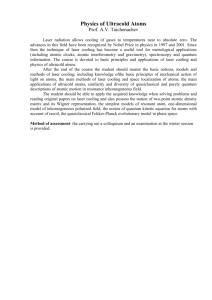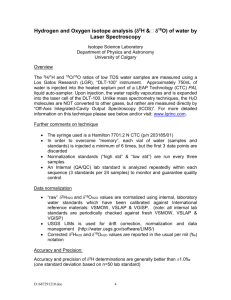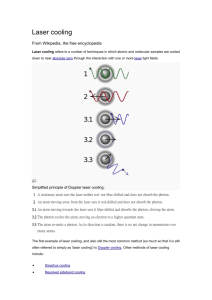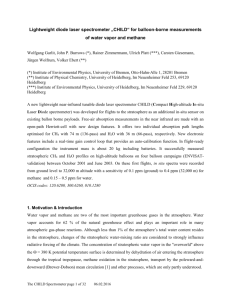Physics 4061 – Outline of Topics Covered by Lectures
advertisement
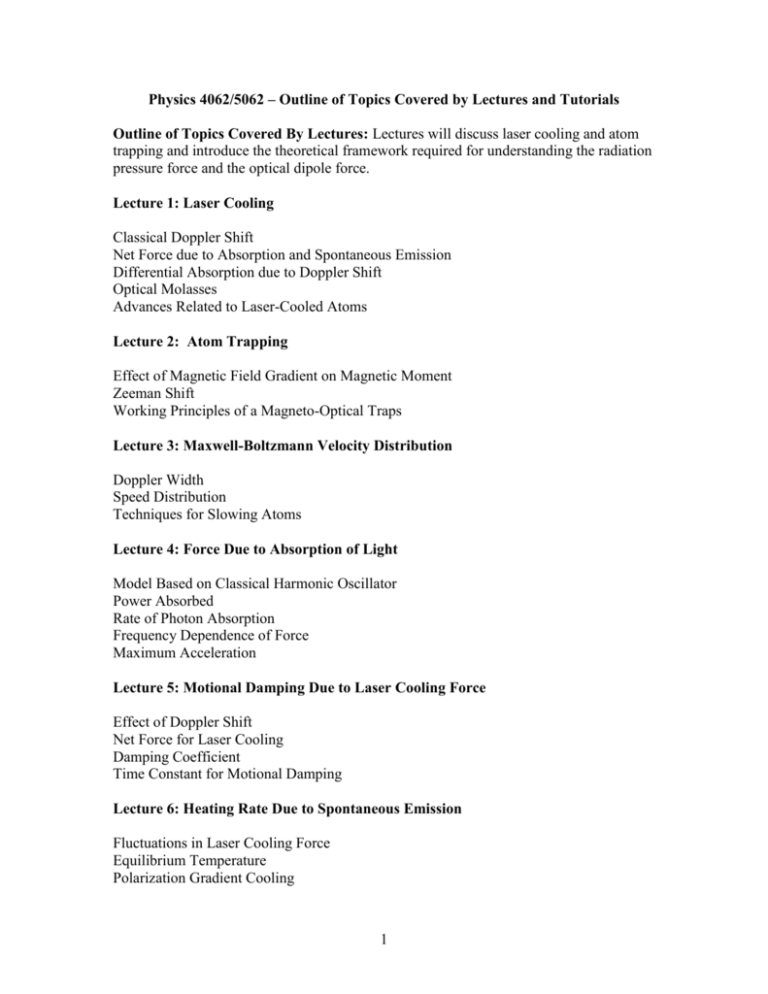
Physics 4062/5062 – Outline of Topics Covered by Lectures and Tutorials Outline of Topics Covered By Lectures: Lectures will discuss laser cooling and atom trapping and introduce the theoretical framework required for understanding the radiation pressure force and the optical dipole force. Lecture 1: Laser Cooling Classical Doppler Shift Net Force due to Absorption and Spontaneous Emission Differential Absorption due to Doppler Shift Optical Molasses Advances Related to Laser-Cooled Atoms Lecture 2: Atom Trapping Effect of Magnetic Field Gradient on Magnetic Moment Zeeman Shift Working Principles of a Magneto-Optical Traps Lecture 3: Maxwell-Boltzmann Velocity Distribution Doppler Width Speed Distribution Techniques for Slowing Atoms Lecture 4: Force Due to Absorption of Light Model Based on Classical Harmonic Oscillator Power Absorbed Rate of Photon Absorption Frequency Dependence of Force Maximum Acceleration Lecture 5: Motional Damping Due to Laser Cooling Force Effect of Doppler Shift Net Force for Laser Cooling Damping Coefficient Time Constant for Motional Damping Lecture 6: Heating Rate Due to Spontaneous Emission Fluctuations in Laser Cooling Force Equilibrium Temperature Polarization Gradient Cooling 1 Lecture 7: Atom Trapping Force Effect of Zeeman Shift on Laser Cooling Force Damped Harmonic Motion Spring Constant of MOT Lecture 8: Semi-classical Description of Atom-Field Interaction Rabi Frequency Time Dependent Evolution of Probability Amplitudes for Weak Fields Atomic Response to Pulsed Excitation Lecture 9: Review of Strong Field Solution Rabi Flopping Pulse Overview of Bloch Vector Model Coupled Equations for Populations and Coherences (components of dipole moment) Lecture 10: Components of Dipole Moment - Harmonic Oscillator Model Coupled Equations and Steady State Solutions-Slowly Varying Envelope Approximation Damping Rates for Energy and Dipole Moment Connection between Absorption and In-quadrature Component of Dipole Moment Lectures 11: Force Due to Absorption of Light-Predictions of Bloch Vector Model Phenomenological Inclusion of Damping Steady State Solutions Intensity and Frequency Dependence of Force Lecture 12: Optical Dipole Force Physical Origin Connection between Index of Refraction and In-Phase Component of Dipole Moment Predictions of Harmonic Oscillator Model Lecture 13: Optical Dipole Force – Predictions of Bloch Vector Model Intensity and Frequency Dependence of Force Scaling Laws in the Far Detuned Limit Loading FORTs from MOTs 2 Outline of Topics Covered By Tutorials: Tutorials will discuss experimental techniques relevant to investigations of the properties of cold atoms. Tutorial 1: Overview of Experimental Setup for realizing a MOT Benchmarks and Timelines Review of Techniques Related to Laser Spectroscopy Amplitude and Frequency Modulation of Trap Laser Remarks on Repump Laser Tutorial 2: Requirements for Polarization of Trapping Beams Effects of Polarizers and Waveplates Mirror Reversal and Time Reversal Tutorial 3: Laser Frequency Stabilization Saturated Absorption Spectra Lock-in Amplifier Lock Points Technique for Setting the Lock-in Phase and monitoring lock jumps Tutorial 4: Atom Number and Density Trap Fluorescence and Atom Number Cloud Size and Density Tutorial 5: Review of Suggested Cold Atom Experiments Scaling Laws for Atom Number and Cloud Size Loading Rate Optical Pumping Temperature Measurements Tutorial 6: Discussion of Lab Report Requirements Sections Grading Scheme 3 Tutorial 7: Techniques for Measuring the Temperature of Laser-Cooled Atoms Time of Flight Techniques based on Dropping Atoms through a Probe Laser CCD Camera Imaging of Cloud Expansion Release and Recapture Tutorial 8: MOT Loading Loading Time Optical Pumping Molasses Decay Tutorial 9: Applications of Laser-Cooled Atoms Atomic Clocks 4



